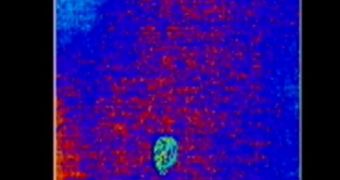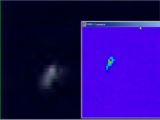The Lunar CRater Observation Sensing Satellite (LCROSS) spacecraft is no more. A few moments ago, the steering spacecraft slammed into the surface of the Moon, just four minutes after its cargo, the spent Centaurus upper rocket stage, slammed in the permanently shadowed regions of the Cabeus crater, on the Moon's south pole. The flight control was aptly performed by experts at the NASA Ames Research Center, who announced that LCROSS crashed several miles away from the Centaurus impact zone, as calculated.
As the impact time drew nearer, excitement slowly built inside the Mission Control at NASA, as engineers watched in awe the lunar surface getting closer and closer, filmed from aboard the LCROSS spacecraft. The target was the darkened area on the left side of the Cabeus crater, just below a smaller impact crater, on the very edge of the rim. Just before crashing, the Science Controller at the NASA Ames Research Center said that the instruments on the LCROSS had picked up thermal signatures of the debris plume kicked up by the spent Centaurus rocket stage, as it impacted the lunar south pole.
Out of the nine instruments aboard the spacecraft, the spectrometers are the most important ones, especially those operating in near-infrared wavelengths. They can essentially break up light into its components, and analyze the chemical composition of its targets. LCROSS also has numerous cameras, which operate from visible light to the thermal infrared wavelengths.
NASA also mentioned that the Lunar Reconnaissance Orbiter (LRO) was in orbit above the south pole of the moon at the time of the LCROSS/Centaurus impact. The craft, which shared the same Atlas V rocket with the recently “deceased” spacecraft, was flying about 50 kilometers above Cabeus, and experts at Ames hope to receive telemetric, spectroscopic, as well as visual data from it within the next couple of hours. Additionally, it will take a few hours until all the telescopes that witnessed the crash will put their data together and a clear conclusion will be inferred from the results.
“Whatever answer we get back, if we see ice or we don't, [it] is going to be significant. So either it's not there, or there's some patchiness and spottiness to it, if it is indeed there. We're going to learn a lot no matter what results are obtained. It has been a lot of work for four minutes of data, but it's a really important four minutes of data. Hopefully, we'll have a variety of data sets that we can combine and make a coherent story. That's the going-in plan,” the LCROSS Observation Campaign lead investigator, Jennifer Heldmann, said a couple of days ago.

 14 DAY TRIAL //
14 DAY TRIAL // 
